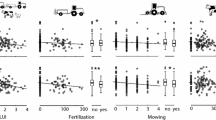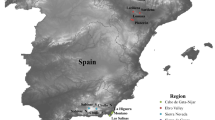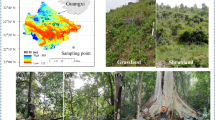Abstract
Species diversity and stability of natural secondary communities in different layers with different cutting intensities 10 years later were investigated by calculating Marglef Richness index (R), Shannon-Wiener diversity index (H), Simpson diversity index (P), and Pielou Evenness index (J). Results show that the values of R, H and P among different layers are listed in a decreasing order: the shrub layer > the arbor layer > the herb layer, all the three indices values reach the maximum under medium selective cutting intensity after 10 years. The J value of the shrub layer shows a concave parabolic change with the increase in cutting intensity; it shows a linear increase for the arbor layer, whereas the J value of the herb layer shows an opposite change pattern. The values of R at different cutting intensities had high significant difference, but other indices had not significant difference. The stability of communities at different cutting intensities after 10 years is non-cutting> low selective cutting intensity > medium selective cutting intensity > high selective cutting intensity > extra-high intensity > clear cutting. The stability of communities at different cutting intensities after 10 years shows that the greater cutting intensities, the worse the stability is.
Similar content being viewed by others
References
Godron M. 1972. Some aspects of heterogeneity in grasslands of Cantal. Statistical Ecology, 3: 397–415.
Indra PS, Mulualem T, Per CO. 2010. Changes in tree species diversity and dominance across a disturbance gradient in Nepalese Sal (Shorea robusta Gaertn. f.) forests. Journal of Forestry Research, 21(1): 25–32
Jin Yong-huan, Li Dun-qiu, Jiang Hao-xiang, Liu Jun, Li Guang-hua. 2006. Changes in species diversity of natural secondary forests after selective cutting disturbance in Changbai Mountain. Journal of Jilin Agricultural University, 28(1): 35–39.(in Chinese)
Lei Xiangdong, Tang Shouzheng. 2000. Progress in quantitative studies on the forest management effects on community diversity. Chinese Journal of Ecology, 19(3): 46–51.(in Chinese)
Liu Yongchuan. 2006. Study of applications of selective cutting management techniques in natural forests. Forest Engineering, 22(5):7–9, 18. (in Chinese)
Margalef R. 1975. Diversity, stability and mutuality in natural ecosystems. In: Dobben W.H., LOWE-MCCONNELL R.H. (Eds) Unifying Concepts in Ecology. Wageningen: Centre for Agricultural Publishing and Documentation, 151–160.
Qiu Renhui, Chen Han. 2005. Effects of selective cutting of different intensities on the tree layer structure and species diversity of evergreen broadleaved forest. Chinese Journal of Eco-Agriculture, 13(3): 158–161.(in Chinese)
Tai Likun, Yu Xuebiao, Yang Zengjiang, Shi Zhongjie, Zhou Weiwei, Guo Junyu. 2009. The compare of the understory vegetation diversity and biomass of three types of forest. Ecology and Environmental Sciences, 18(1): 237–242. (in Chinese)
Tilman D. 2000. Causes, consequences and ethics of biodiversity. Nature, 405: 208–211.
Zhang Feng, Zhang Jingtun, Shangguang Tieliang. 2002. Plant diversity of forest community in Zhuweigou of Lishan Mountain Nature Reserve. Acta Phytoecologica Sinica, 26(S1): 46–51. (in Chinese)
Zheng Yuanrun. 2000. Comparison of methods for studying stability of forest community. Scientia Silvae Sinicae, 36(5): 28–32. (in Chinese)
Zhou Xinnian, Wu Zhilong, Zheng Lifeng, Cai Ruitian, Luo Jizhang, Lin Haiming. 2008. Biomass and nutrient content of forest litter in natural forest of different intensity harvesting after ten years. Scientia Silvae Sinicae, 44(10): 25–28. (in Chinese)
Zhou Xinnian, Wu Zhilong, Zheng Lifeng, Deng Shengmei, Lin Haiming, Xu Shaohong. 2007. Research progress on forest selective cutting. Journal of Mountain Science, 25(6): 629–636.(in Chinese)
Zhou Zhichun, Xu Gaofu, Jin Guoqing, He Jianping. 2004. Growth of broad-leaved species and community restoration of secondary masson Pine forest after selective cutting. Forest Research, 17(4): 420–426.(in Chinese)
Zhu Jinmao, Jiang Zhilin, Jiang Wei, Zheng Qunrui, Jiang Xunqiang. 1997. The effects of human caused disturbance on species diversity of forest community in northern Fujian Province. Biodiversity Science, 5(4): 24–31.(in Chinese)
Author information
Authors and Affiliations
Corresponding author
Additional information
Foundation project: This work was supported by National Natural Science Foundation of China (30972359, 31070567), the Natural Science Foundation of Fujian Province (No.2006J0301, No.2008J0327, No.2009J0101), the Science Foundation of Science Technology of Fujian Province (No.2007N0002, No.2006F5006, No.2007F5010), the Science Foundation of Forestry Committee of Fujian Province (Forestry Science of Fujian[2006] No.7,No.14)
Rights and permissions
About this article
Cite this article
Wu, Zl., Zhou, Xn., Zheng, Lf. et al. Species diversity and stability of natural secondary communities with different cutting intensities after ten years. Journal of Forestry Research 22, 205–208 (2011). https://doi.org/10.1007/s11676-011-0151-2
Received:
Accepted:
Published:
Issue Date:
DOI: https://doi.org/10.1007/s11676-011-0151-2




